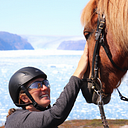The Perfect Warm-Up with Your Horse

“Krystal, what the hell was that?” My hot-tempered, Italian boss shouted at me. It was my first week of work at this gorgeous private show jumping stable, nestled on the hillside overlooking the Mediteranean sea, and already my boss was annoyed with me.
“Umm…” I stumbled for words. I’d only just sat on the horse for 10 minutes when he stopped me. I was 22 years old at the time, and although this was already the fifth country I’d worked at high level show jumping yards, I still had much to learn.
“That’s no way to warm up a horse,” His hands began waving in that Italian-style that I’d, until now, only witnessed in movies.
I had mounted the horse and only thus far walked him on the buckle one round each direction, and trotted on the buckle with the horse stretching to the floor in each direction. After I’d done the same in canter, I’d assumed my warm-up was done and had begun to pick up the reins.
“You can’t just float around the arena on the rail!” He cried. “You must be interesting.” My eyebrow pricked, ready to receive further instruction.
“Krystal, bella,” his italian charm kicked in. “I want no less than 100 transitions in the next 10 minutes. This horse’s hooves must have touched every inch of the arena at least once, and not more than twice.” He pointed to the rail, motioning for me to start. “And don’t even think about staying on the rail for more than a stride or two!”
And with that, I was off.
Later, while working with one of the highest level FEI coaches in the world, a similar story was shared with me, “The warm up is just like a pilot about to fly a plane. The pilot checks all the lights, pushes all the buttons and checks that everything is working before taking off.”
The ideal warm-up for a horse has two parts to it. The first part is relaxation and stretching (the one-thing I had done correctly in my Italian boss’s eyes that day). This allows the horse’s muscles to loosen up, their joints to move and their backs and muscles to literally “warm,” just like humans stretch before going for a long run or lifting heavy weights.
The second part of the warm up is not to teach the horse anything new (that is for your working session) but to simply check the engine lights, look for a full tank of gas, be mindful of any warning lights and test that all the installed buttons are working.
The best way to warm-up a horse is lots and lots of transitions (aim for 100 and be happy with 50) as well as covering as much of the arena as possible. You don’t want to make tight turns or circles during the warm-up, but don’t be shy to play with new patterns and figures.
A warm-up, when done properly makes for an engaged and interested horse, and also one that is less likely to get injured, or disagree with you later on when you go to teach them something new (or perfect what they already know/perform at a show, etc.)
So the next time you plan to ride your horse, try not to just focus on the “meat of the ride” but perhaps spend a little time in your warm-up doing a pre-flight check.
FREE 3 Day Virtual Clinic: https://www.theinternationalequestrian.com/summit-register
Speaking the Horse Language Online Course: https://catalog.equestrianadventuresses.com/shl-course
Resources for Equestrians: https://catalog.equestrianadventuresses.com/resources
